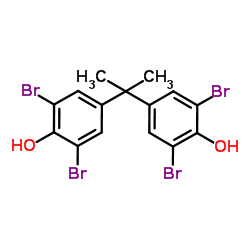Tetrabromobisphenol A

Tetrabromobisphenol A structure
|
Common Name | Tetrabromobisphenol A | ||
|---|---|---|---|---|
| CAS Number | 79-94-7 | Molecular Weight | 543.871 | |
| Density | 2.1±0.1 g/cm3 | Boiling Point | 417.9±40.0 °C at 760 mmHg | |
| Molecular Formula | C15H12Br4O2 | Melting Point | 178-181 °C(lit.) | |
| MSDS | Chinese USA | Flash Point | 206.6±27.3 °C | |
| Symbol |

GHS09 |
Signal Word | Warning | |
|
Photochemical transformation of tetrabromobisphenol A under simulated sunlight irradiation: Kinetics, mechanism and influencing factors.
Chemosphere 134 , 550-6, (2015) A systematic study on photolysis of tetrabromobisphenol A (2,2',6,6'-tetrabromo-4,4'-isopropylidendiphenol, TBBPA) in water was investigated under simulated sunlight irradiation. The results showed that the photolysis of TBBPA followed apparent pseudo-first-o... |
|
|
Analytical capabilities of high performance liquid chromatography - Atmospheric pressure photoionization - Orbitrap mass spectrometry (HPLC-APPI-Orbitrap-MS) for the trace determination of novel and emerging flame retardants in fish.
Anal. Chim. Acta 898 , 60-72, (2015) A new analytical method was established and validated for the analysis of 27 brominated flame retardants (BFRs), including so called "emerging" and "novel" BFRs (EBFRs and NBFRs) in fish samples. High performance liquid chromatography (HPLC) coupled to Orbitr... |
|
|
Flame retardant emission from e-waste recycling operation in northern Vietnam: environmental occurrence of emerging organophosphorus esters used as alternatives for PBDEs.
Sci. Total Environ. 514 , 492-9, (2015) Three oligomeric organophosphorus flame retardants (o-PFRs), eight monomeric PFRs (m-PFRs), tetrabromobisphenol A (TBBPA), and polybrominated diphenyl ethers (PBDEs) were identified and quantified in surface soils and river sediments around the e-waste recycl... |
|
|
Elucidating toxicological mechanisms of current flame retardants using a bacterial gene profiling assay.
Toxicol. In Vitro 29 , 2124-32, (2015) Flame retardants are ubiquitously used chemicals that have been shown to contaminate environments. Toxicological data is largely limited, with little insight into their molecular modes of action that may give rise to their toxic phenotypes. Such insight would... |
|
|
Molecularly imprinted solid-phase extraction for selective extraction of bisphenol analogues in beverages and canned food.
J. Agric. Food Chem. 62(46) , 11130-7, (2014) This study aimed to develop a selective analytical method for the simultaneous determination of seven bisphenol analogues in beverage and canned food samples by using a new molecularly imprinted polymer (MIP) as a sorbent for solid-phase extraction (SPE). Liq... |
|
|
Multi-analyte method for the analysis of various organohalogen compounds in house dust.
Anal. Chim. Acta 854 , 61-9, (2014) In the present study, a novel analytical approach for the simultaneous determination of 27 brominated flame retardants (BFRs), namely polybrominated diphenyl ethers (PBDEs), isomers of hexabromocyclododecane (HBCD), tetrabromobisphenol A (TBBPA) and several n... |
|
|
[Components of plastic disrupt the function of the nervous system].
Postepy. Hig. Med. Dosw. 67 , 499-506, (2013) Development of the chemical industry leads to the development of new chemical compounds, which naturally do not exist in the environment. These chemicals are used to reduce flammability, increase plasticity, or improve solubility of other substances. Many of ... |
|
|
Concurrent degradation of tetrabromobisphenol A byOchrobactrumsp. T under aerobic condition and estrogenic transition during these processes
Ecotoxicol. Environ. Saf. 104 , 220-5, (2014) The effect of concurrent degradation of tetrabromobisphenol A (TBBPA) by the strain Ochrobactrum sp. T under aerobic condition was investigated. The results demonstrated that four extra energy source-addition systems still followed pseudo-first order kinetics... |
|
|
Structural bisphenol analogues differentially target steroidogenesis in murine MA-10 Leydig cells as well as the glucocorticoid receptor.
Toxicology 329 , 10-20, (2015) Although much information on the endocrine activity of bisphenol A (BPA) is available, a proper human hazard assessment of analogues that are believed to have a less harmful toxicity profile is lacking. Here the possible effects of BPA, bisphenol F (BPF), bis... |
|
|
Fate and metabolism of tetrabromobisphenol A in soil slurries without and with the amendment with the alkylphenol degrading bacterium Sphingomonas sp. strain TTNP3.
Environ. Pollut. 193 , 181-8, (2014) Transformation of ring-(14)C-labelled tetrabromobisphenol-A (TBBPA) was studied in an oxic soil slurry with and without amendment with Sphingomonas sp. strain TTNP3, a bacterium degrading bisphenol-A. TBBPA degradation was accompanied by mineralization and fo... |